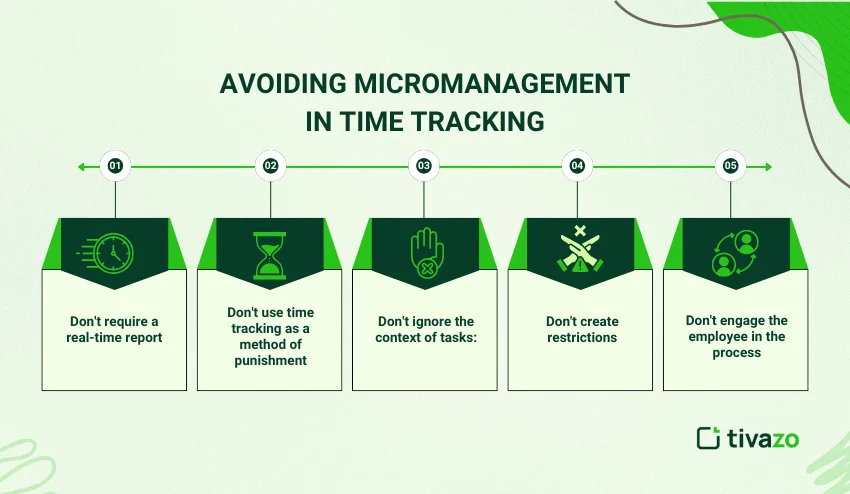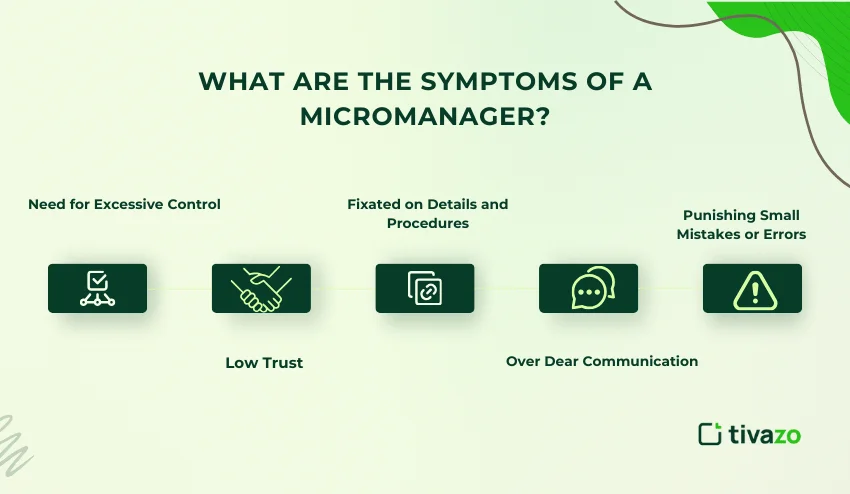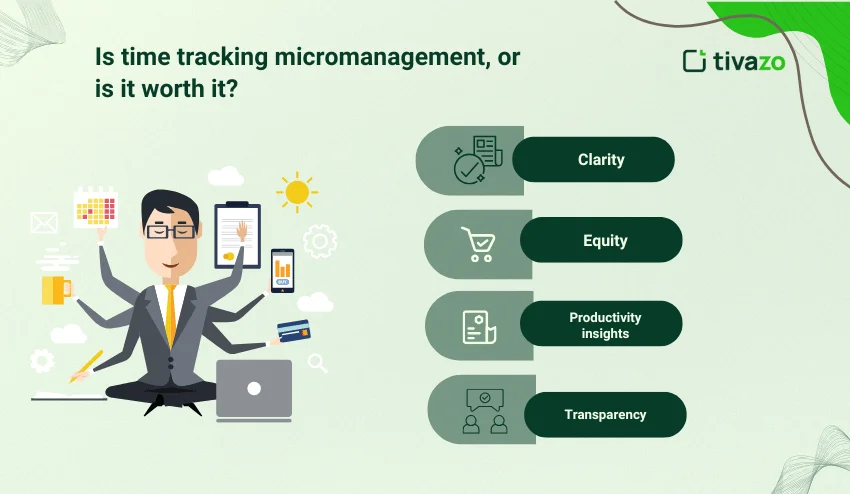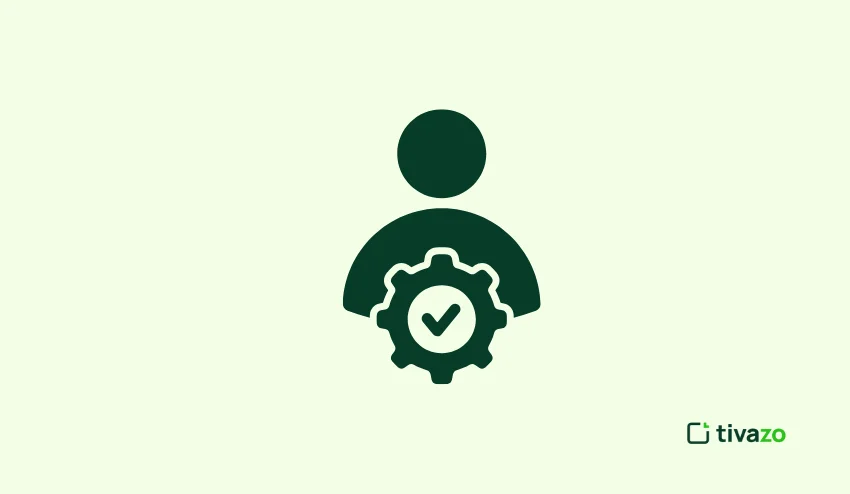Time tracking is commonplace at work today. Which begs the question: Is time tracking micromanagement? For some employees, the time tracking is somehow a sign of their boss not trusting them. For managers, time tracking is a way to observe who is doing any work, who is doing productive work, and who is not doing any work at all. The real question is not whether we have time tracking, but how we can implement time tracking as part of our process.
Conversations regarding whether is time tracking micromanagement are gaining traction because, for employees, time tracking can feel very related to the idea of being under surveillance, and for leaders, time tracking is a way to help create work and improve efficiencies. When done poorly or the wrong way, time tracking can stifle a person’s creativity/autonomy and can erode someone’s engagement. When done well, time tracking can produce efficiencies, help reduce burnout, and create a sense of accountability within groups.
I want to explore the question of is time tracking micromanagement. I will explore what it is about time tracking in some instances that causes the action to become micromanagement, as well as some of the pitfalls crews need to be mindful of to avoid for their employees. Lastly, I will encourage time tracking practices that create a sense of good practice and that create opportunities for growth rather than a management control mechanism.
What is Time Tracking?
Time tracking entails tracking the time dedicated to various tasks, projects, and other activities. Time tracking can be completed manually using spreadsheets/timesheets, or automatically with the help of apps and software used for tracking time. Organizations are primarily using time tracking as a way to measure productivity, analyze workflow, and manage project expenses.
Many workers ask the question: Is time tracking micromanagement? The concern is legitimate when managers are using time tracking to monitor every minute detail instead of empowering their team.
When done right, time tracking can shed light on task visibility, accountability, and efficiency. Time tracking allows organizations to:
- Identify bottlenecks to see where the tasks take more time than they actually need.
- Allow project managers to reallocate resources in the project if they see someone’s workload is imbalanced and needs to be even.
- Recognize employee burnout, to the point of recognizing an employee’s overwork by actually tracking their hours.
- Employees are being transparent to understand how their progress or work relates to goals.
- Enhance productivity through data-driven insights to see what time tracking data tells you about efficiency and working smarter.
However, when time tracking is misused, it could be perceived as surveillance. When this goes astray, it starts another debate: is time tracking micromanagement- a debate that is continuously growing in modern workplaces.
Is Tracking Employee Time Micromanagement?
To understand this concept, the central question is time tracking micromanagement. The short answer depends totally on your intention.
- Tracking for Monitoring Purposes: If leaders track their employees on every second of work done, then yes, this is micromanagement of time.
- Tracking for Insights and Support: If managers are tracking the time their employees work in order to gather data for continuous improvement of workflows and buy-in from the employee, then time tracking is not micromanaging. In fact, time tracking can be an asset to increasing productivity.
- Trust is Important: Micromanagement is born out of a lack of trust from a leader, through excessive oversight of a team. This constant state of being overseen diminishes feelings of comfort, resulting in distress, bud us what comfort is negatively impacted by micromanagement because lack of trust triggers tension.
- Focus on Support System Approach: Is time tracking micromanagement explained and framed as a tool to help employees plan their work day, recognize and avoid distractions, and document their productive accomplishments, then time tracking is not micromanagement.
- Context Drives the Impact: Time tracking as a tool in and of itself is not negative. However, the level of employee engagement with the time tracking becomes influenced by the behaviors of the leader, specifically communication and intent.
When leaders focus on guidance and empowerment instead of control, time tracking can become more productive and less micromanaging. The question remains: Is time tracking micromanagement?

What Makes Time Tracking Micromanagement?
A few factors can lead employees to feel as though is time tracking micromanagement. When leaders understand these conditions, they can help avoid a useful practice from becoming a source of stress.
1. Inordinate Monitoring
When every moment must be justified, employees feel as if they are always being monitored instead of being trusted. Managers’ constant observations can lead employees to question their autonomy and, in turn, lose motivation. Time tracking becomes a micromanagement practice rather than a tool for managing productivity.
2. Punishing Use
If managers are using Is time tracking micromanagement to punish minor variations shown in hours tracked, time tracking changes from monitoring and oversight to control. Employees may hide the way they spend their hours and ultimately report inaccurately on their time. The change demonstrates micromanagement in the workforce and is often a consequence of a negative or punitive consequence employed by management.
3. Lack of Transparency
In the event leaders do not explain why the time tracking is used, employees often perceive it as monitoring or surveillance. When management does not clarify its intentions, the sense of trust erodes, and the phrase “is time tracking micromanagement” presents itself. Being transparent about the reasons and outcomes for using time tracking is a means for illustrating time tracking as a potentially supportive representative rather than a part of management controlling behavior.
4. Excessive Focus on Data
Another way is time tracking micromanagement? Focusing on logged hours while ignoring creativity, collaboration, or results patently diminishes engagement and impedes innovation as employees likely feel they’re being reduced to metrics rather than being recognized for real contributions.
5. Deficits in Feedback
With employee time tracking, there is a normal sense employees feel monitored about their work, but lack a sense of support from their contracting agency when time tracking is done without proper and consistent feedback. Constructive conversations can take raw data and turn it into usable information that employees can develop into actionable feedback, and by skipping that step, time tracking has become micromanagement!
In summary, the difference is in the mechanics. If used with caution, time tracking is not micromanagement; it is improving workflow, enhancing productivity, and growing accountability. If used harshly, however, it answers the assessment question, “Is time tracking micromanagement?” emphatically and definitively. Leaders ought to clearly utilize time tracking as a mechanism to support performance growth and both transparency and trust, rather than monitoring every action and movement.
Avoiding Micromanagement in Time Tracking
To avoid micromanagement, managers need to avoid these don’ts to ensure that time tracking is a part of the solution to improve productivity and not a form of micromanagement.
- Don’t require a real-time report: Asking employees “what are you working on now?” reinforces the message that time tracking is another form of micromanagement and creates anxiety for employees.
- Don’t use time tracking as a method of punishment: If tracked hourly or tracked time is used against employees in a punitive way, trust is ruined. Time tracking, used to reveal workload balance or identify process improvements, can improve productivity and trust.
- Don’t ignore the context of tasks: Sometimes, the nature of the task is the reason why it takes longer than expected, due to a lack of authority or other outside contexts. Ignoring these situations is a sign that you are treating time tracking as a form of micromanagement instead of a useful method of reporting productivity.
- Don’t create restrictions: For instance, if you require employees to log every hour down to a second, you help an employee confirm that it is time tracking micromanagement, instead of empowering employees through the process.
- Don’t engage the employee in the process: By involving your employees in goal setting and conversations around how time spent is strategic to the success of the team, you have more visible transparency and a lower chance of structuring time tracking feeling like another type of micromanagement.
When these errors are circumvented, time tracking remains a collaborative tool for efficiency, accountability, and performance insights. Leaders who communicate clearly about time tracking, provide context, and ask for feedback can help time tracking become an efficiency booster – as opposed to something related to control or stressful situations. For a time-tracking process to be properly implemented, it has to respond to an ongoing question: Is time tracking micromanagement? The answer comes down to intention, transparency, and trust.

What Counts As Micromanagement?
Micromanagement is a leadership style where a leader is overly involved with employees, providing little room for independence. It can manifest in classic signs such as.
- Asking for a constant update.
- Re-doing work. (When it is not necessary.)
- Focusing on minute details, not on the outcome.
- Demonstrating a lack of trust in the decision-making activities.
So, in this context, is time tracking micromanagement, and only if it shows these characteristics. If a leader were only focused on numbers (without trust), it would be micromanaging. If it promotes accountability and independence, it is a productivity firm.
Ultimately, micromanaging damages team morale, dampens innovation, and increases employee turnover. This is why many organizations are re-examining how they use time tracking to support teams, rather than holding them back.
What are the symptoms of a micromanager?
If you are wondering whether “time tracking is micromanagement,” it is vital to recognize the symptoms of micromanagers. The following are common symptoms:
- Need for Excessive Control: Needing to be aware of everything other people are doing at the moment.
- Low Trust: Having a lack of confidence in employees’ abilities to complete work on their own.
- Fixated on Details and Procedures: Being consumed by how the work is done vs. what the result is.
- Over Dear Communication: Too many check-ins, meetings, and status updates.
- Punishing Small Mistakes or Errors: Looking for reasons to mistake through time tracking or other measures.
When any of these traits are employed with time tracking, it is a clear answer to the question, “Is time tracking micromanagement?” Yes, if managers are using it as a method of control, it engenders micromanagement and can easily engender distrust.
The true challenge for leaders is to see the signs before it is too late and adjust as is proper. Failure to do so, then employees disengaging, performance declines, and the effectiveness of time tracking fades.

Healthy Time Tracking vs Micromanagement via Tracking
| Aspect | Healthy Time Tracking | Micromanagement via Tracking |
| Purpose | Increase productivity & planning | Control everything down to the detail |
| Employee Experience | Empowering and transparent | Distrustful and frightening |
| Feedback | Fair and collegial | Punitive and unilateral |
| Focus | Outcomes and efficiency | Only hours and minutes |
| Trust Level | High trust in data-informed decisions | Low trust in fear-informed decisions |
Is time tracking micromanagement, or is it worth it?
Answer: yes, it’s worth it—if done correctly.
Time tracking provides:
- Clarity: Employees can see where their time goes.
- Equity: Workloads can be balanced objectively.
- Productivity insights: Teams gain knowledge of which tasks suck up their time.
- Transparency: Managers and employees are on the same page about purpose.
However, time tracking should never become tracking for surveillance. The best companies focus on results, not hours, and allow autonomy for employees, while using time tracking as a supportive measure.
So, is time tracking micromanagement? It can be, but it does not have to be. It all depends on the behavior of management.

Conclusion
Tracking time is a strong tool for productivity, but many wonder: Is time tracking micromanagement? The answer depends on how it’s used. If you track time to monitor what employees do for every minute of the day, to punish minor mistakes, or if you are only interested in a time log of hours worked, then yes, tracking time is probably micromanaging.
However, if you use time to track only with clear objectives, context, and employee involvement, then tracking time can support a team, create accountability, and create workflow. Key concerns usually involve excessive monitoring, punitive, strict rules, and a lack of feedback. Leaders interested in development and growth can take time tracking from a potential micromanagement activity to a positive intervention.
The intention, trust, and communication of the tracking process is really what determines, “Is time tracking micromanagement?” The right way to track time can increase productivity while enhancing employees’ autonomy at work and morale.




